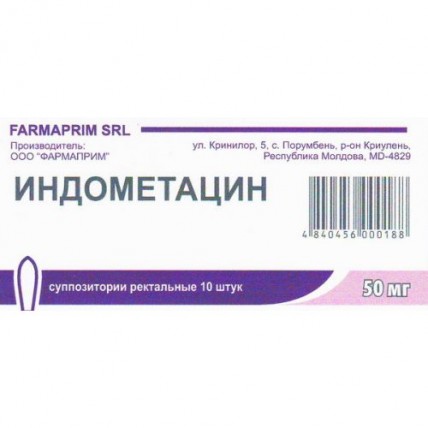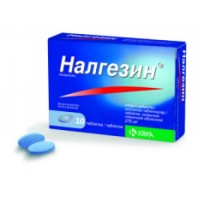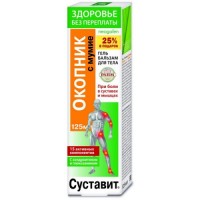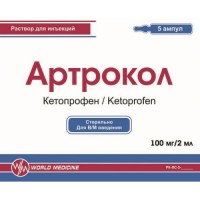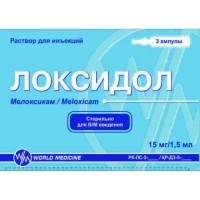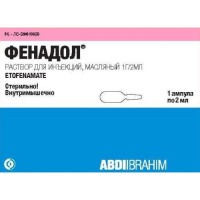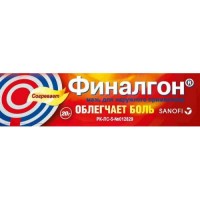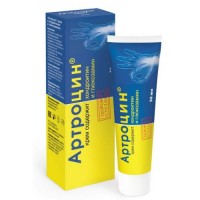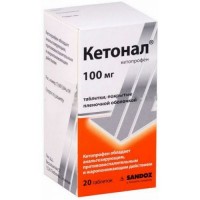Indomethacin 50 mg rectal suppositories 10s
- $3.80
The instruction for medical use
of INDOMETACIN medicine
the Trade name
Indometacin
the International unlicensed
name Indometacin Dosage Form
Suppositories rectal, 50 mg
Structure
One suppository contains
active agent - indometacin of 50 mg,
excipients: cetyl alcohol, suppotsir AM (solid fat).
The description
Suppositories of a tsilindrokonichesky form, white color with a yellowish shade. On a cut the existence of an air, porous core and funneled deepening
Pharmacotherapeutic group
Anti-inflammatory and antirheumatic drugs is allowed. Non-steroidal anti-inflammatory drugs. Acetic acid derivatives. Indometacin.
ATH code: M01AB01
the Pharmacological
Pharmacokinetics Bioavailability properties of indometacin at rectal use makes 80-90%. The maximum concentration (With max) is reached in 1 h. Communication with proteins of blood plasma makes 90%. Passes hematoencephalic and placentary barriers. Gets into synovial fluid and breast milk. Elimination half-life makes 4-9 h. It is metabolized in a liver. Is exposed to enterohepatic recirculation. Kidneys remove 70% of drug in the form of metabolites and in not changed look (30%) and digestive tract – 30% in the form of metabolites.
The pharmacodynamics
Indometacin has anti-inflammatory, analgetic and febrifugal effect. The mechanism of action is connected with not selective inhibition of isoenzymes of cyclooxygenase (TsOG1 and TsOG2) that leads to oppression of synthesis of prostaglandins from arachidonic acid. Anti-inflammatory action is caused by influence both on exudative, and on a proliferative phase of inflammation. Suppresses aggregation of thrombocytes.
In rheumatic diseases the anti-inflammatory and analgeziruyushchy properties cause easing or disappearance of such symptoms as, a rest pain and at the movement, morning rigidity, a swelling of joints and improvement of functional capacities. Promotes easing or disappearance of a pain syndrome of not rheumatic character, including at the inflammatory processes arising after operations and injuries reduces inflammatory hypostasis on the place of a wound. At primary algodismenorea drug reduces pain. The anti-inflammatory effect occurs by the end of the first week of treatment.
Indications
- inflammatory and degenerative diseases of the musculoskeletal system: the pseudorheumatism, psoriasis arthritis, gouty arthritis, juvenile arthritis ankylosing a spondylitis, an osteoarthrosis, osteochondrosis, neuralgia, myalgias and dr
- rheumatic defeats of soft tissues, traumatic inflammation of soft tissues and joints,
- as supportive application as a part of complex therapy in infectious and inflammatory diseases of ENT organs, an adnexitis, prostatitis, cystitis, neuritis, algodismenory, head and a toothache.
Route of administration and
Rektalno's doses.
The adult appoint on 1 suppository (50 mg) 2 - 3 times a day or on 1 suppository (100 mg) of 1 - 2 time a day.
The maximum daily dose makes 200 mg.
A maintenance dose – 50 - 100 mg of 1 times a day, for the night.
Duration of a course of treatment is established by the doctor individually.
Duration of treatment of drug should not exceed 7 days.
Side effects
- disturbance of taste, nausea, vomiting, heartburn, loss of appetite, abdominal pains, a constipation or diarrhea, an abnormal liver function (increase in activity of 'hepatic' transaminases, a hyperbilirubinemia), erosive cankers of the digestive tract (DT), perforation of a GIT at prolonged use in high doses
- bleedings (gastrointestinal, gingival, uterine, hemorrhoidal), petechias, ecchymomas, a purpura
- dizziness, a headache, insomnia, excitement, alarm, irritability, a faint, fatigue, drowsiness, a depression, peripheral neuropathy, muscle weakness, involuntary muscular twitchings, mental disorders (depersonalization, psychotic episodes), paresthesias, a dysarthtia, parkinsonism
- decrease in hearing, sonitus, a diplopia, illegibility of visual perception, turbidity of a cornea, conjunctivitis, orbital and periorbital pains
- heart failure, arrhythmia, a tachyarrhythmia, arterial hypertension, arterial hypotension, thorax pains
- a renal failure, a proteinuria, a hamaturia, interstitial nephrite, a nephrotic syndrome, a renal failure
- skin rash, a skin itching, a small tortoiseshell, exfoliative dermatitis, a multiformny erythema, a toxic epidermal necrolysis, a Quincke's disease, dispnoe, a bronchospasm, a fluid lungs, Stephens-Johnson's syndrome, a Lyell's disease, a knotty erythema, an acute anaphylaxis
- aplastic anemia, autoimmune hemolytic anemia, an agranulocytosis, a leukopenia, thrombocytopenia, DVS a syndrome, a hyperglycemia, a glucosuria, a hyperpotassemia
- aseptic meningitis (is more often at patients with autoimmune diseases)
- the increased perspiration
- hypostases peripheral
- burning, an itching, irritation of a mucous membrane of a rectum, exacerbation of chronic hemorrhoids, colitis
- increase and tension of mammary glands, a gynecomastia
- stomatitis, gastritis, hepatitis, jaundice.
Contraindications
- hypersensitivity to indometacin, acetylsalicylic acid or other non-steroidal anti-inflammatory drugs with manifestations of an urticaria, rhinitis, conjunctivitis, an attack of bronchial asthma (including aspirinovy bronchial asthma)
- congenital heart diseases (aorta coarctation, an atresia of a pulmonary trunk, Fallo's tetrad)
- heavy arterial hypertension
- heavy heart failure, coronary heart disease of the III functional class
- hemophilia, hypocoagulation, thrombocytopenia
- a leukopenia and anemia
- decrease in hearing, pathology of a vestibular mechanism
- disturbance of color sight, a disease of an optic nerve
- deficit glyukozo-6-fosfatdegidrogenazy
- a proctitis, hemorrhoids in aggravation stages, rectal bleeding
- erosive cankers of a stomach and duodenum in an aggravation phase
- ulcer colitis, Crohn's disease
- bleedings (gastrointestinal, cerebrovascular or other active bleedings)
- a serious illness of a liver and kidneys
- pancreatitis
- epilepsy
- a depression and other mental disorders
- parkinsonism
- pregnancy and the period of a lactation
- children's and teenage age up to 18 years
- states after surgical interventions.
Medicinal interactions
Enhances side effects of mineralokortikoidny, glucocorticoid drugs, estrogen and other non-steroidal anti-inflammatory drugs.
Strengthens effect of indirect anticoagulants, antiagregant, trombolitik and increases risk of developing bleedings.
Increases concentration in plasma of digoxin, a methotrexate and drugs of lithium that can lead to strengthening of their toxicity.
Sharing with paracetamol, cyclosporine and drugs of gold increases risk of development of nefrotoksichny effects.
At combined use with ethanol, colchicine, glucocorticoids and corticotropin increase risk of development of the gastrointestinal complications accompanied with bleedings.
Strengthens hypoglycemic effect of insulin and oral hypoglycemic medicines.
Reduces effects of kaliysberegayushchy, thiazide and loopback diuretics, against the background of use of kaliysberegayushchy diuretics the risk of a hyperpotassemia increases.
Reduces efficiency of uricosuric, hypotensive drugs (including beta blockers).
Miyelotoksichny medicines strengthen manifestations of a gematotoksichnost of drug.
Exponentiates toxic action of a zidovudine.
At combined use with tsefamandoly, tsefoperazony, valproic acid - increase risk of developing a prothrombinopenia and danger of bleedings.
Reduces elimination of penicillin.
Reduces renal clearance of drugs of lithium and brakes vazodilatiruyushchy effect of nitroglycerine.
Special instructions
With care appoint drug in coronary heart disease, cerebrovascular diseases, chronic heart failure, a dislipidemiya, a lipidemia, diabetes, diseases of peripheral arteries, arterial hypertension, smoking, chronic kidney disease (KK of 30-60 ml/min.), cirrhosis with portal hypertensia, hyperbilirubinemias, erosive and ulcer diseases of digestive tract in the anamnesis, presence of an infection of H. pylori, long use of non-steroidal anti-inflammatory drugs, allergic rhinitis, polyps mucous a nose, the bronchial asthma, frequent alcohol intake, heavy somatopathies accompanying therapy by anticoagulants (including warfarin), antiagregant (including acetylsalicylic acid, klopidogret), oral glucocorticosteroids (including Prednisolonum), selective serotonin reuptake inhibitors (including to tsitalopra, fluoxetine, paroksetin, sertraline), to patients of advanced age, women of reproductive age - development of infertility against the background of use of non-steroidal anti-inflammatory drugs is possible.
During long-term treatment the control of a functional condition of a liver and kidneys and a picture of peripheral blood is necessary.
In need of definition of 17 ketosteroids, drug should be cancelled in 48 hours prior to a research.
For reduction of risk of development of the undesirable phenomena from digestive tract it is necessary to use a minimal effective dose minimum possible short course.
The feature of influence of medicine on ability to run the vehicle or potentially dangerous mechanisms
during treatment should abstain from control of motor transport and potentially dangerous mechanisms demanding concentration of attention and speed of psychomotor reactions.
Overdose
Symptoms: nausea, vomiting, severe headache, dizziness, disturbances of memory and disorientation. In more hard cases paresthesias, numbness of extremities, convulsions are observed.
Treatment is symptomatic. The hemodialysis is inefficient.
A form of release and packing
On 5 or 6 suppositories in blister strip packaging from a film polyvinylchloride laminated by polyethylene.
On the 2nd blister strip packagings No. 5 or 1 blister strip packaging No. 6 together with the instruction for medical use in the state and Russian languages in a cardboard pack.
To Store storage conditions in the dry, protected from light place, at
a temperature not over 25 oc. Not to freeze.
To store out of children's reach!
3 years
not to apply a period of storage after an expiration date.
Prescription status
According to the prescription
LLC PHARMAPRIM Producer,
Krinilor St., 5, the village Porumben, the area Kriulen,
the Republic of Moldova, MD-4829
ph.: (+373-22)-28-18-45, ph. / fax: (+373-22)-28-18-46,
the Owner of the registration certificate
of LLC PHARMAPRIM
the Address of the organization accepting in the territory of the Republic of Kazakhstan claims from consumers on quality of products (goods)
Representative office of LLC PHARMAPRIM in Republic of Kazakhstan, Almaty, Gogol St., 86, office 528, ph. 8-727-2796518 of farmaprim.kz@farmaprim.md
to Develop www.farmaprim.md
of INDOMETACIN medicine
the Trade name
Indometacin
the International unlicensed
name Indometacin Dosage Form
Suppositories rectal, 50 mg
Structure
One suppository contains
active agent - indometacin of 50 mg,
excipients: cetyl alcohol, suppotsir AM (solid fat).
The description
Suppositories of a tsilindrokonichesky form, white color with a yellowish shade. On a cut the existence of an air, porous core and funneled deepening
Pharmacotherapeutic group
Anti-inflammatory and antirheumatic drugs is allowed. Non-steroidal anti-inflammatory drugs. Acetic acid derivatives. Indometacin.
ATH code: M01AB01
the Pharmacological
Pharmacokinetics Bioavailability properties of indometacin at rectal use makes 80-90%. The maximum concentration (With max) is reached in 1 h. Communication with proteins of blood plasma makes 90%. Passes hematoencephalic and placentary barriers. Gets into synovial fluid and breast milk. Elimination half-life makes 4-9 h. It is metabolized in a liver. Is exposed to enterohepatic recirculation. Kidneys remove 70% of drug in the form of metabolites and in not changed look (30%) and digestive tract – 30% in the form of metabolites.
The pharmacodynamics
Indometacin has anti-inflammatory, analgetic and febrifugal effect. The mechanism of action is connected with not selective inhibition of isoenzymes of cyclooxygenase (TsOG1 and TsOG2) that leads to oppression of synthesis of prostaglandins from arachidonic acid. Anti-inflammatory action is caused by influence both on exudative, and on a proliferative phase of inflammation. Suppresses aggregation of thrombocytes.
In rheumatic diseases the anti-inflammatory and analgeziruyushchy properties cause easing or disappearance of such symptoms as, a rest pain and at the movement, morning rigidity, a swelling of joints and improvement of functional capacities. Promotes easing or disappearance of a pain syndrome of not rheumatic character, including at the inflammatory processes arising after operations and injuries reduces inflammatory hypostasis on the place of a wound. At primary algodismenorea drug reduces pain. The anti-inflammatory effect occurs by the end of the first week of treatment.
Indications
- inflammatory and degenerative diseases of the musculoskeletal system: the pseudorheumatism, psoriasis arthritis, gouty arthritis, juvenile arthritis ankylosing a spondylitis, an osteoarthrosis, osteochondrosis, neuralgia, myalgias and dr
- rheumatic defeats of soft tissues, traumatic inflammation of soft tissues and joints,
- as supportive application as a part of complex therapy in infectious and inflammatory diseases of ENT organs, an adnexitis, prostatitis, cystitis, neuritis, algodismenory, head and a toothache.
Route of administration and
Rektalno's doses.
The adult appoint on 1 suppository (50 mg) 2 - 3 times a day or on 1 suppository (100 mg) of 1 - 2 time a day.
The maximum daily dose makes 200 mg.
A maintenance dose – 50 - 100 mg of 1 times a day, for the night.
Duration of a course of treatment is established by the doctor individually.
Duration of treatment of drug should not exceed 7 days.
Side effects
- disturbance of taste, nausea, vomiting, heartburn, loss of appetite, abdominal pains, a constipation or diarrhea, an abnormal liver function (increase in activity of 'hepatic' transaminases, a hyperbilirubinemia), erosive cankers of the digestive tract (DT), perforation of a GIT at prolonged use in high doses
- bleedings (gastrointestinal, gingival, uterine, hemorrhoidal), petechias, ecchymomas, a purpura
- dizziness, a headache, insomnia, excitement, alarm, irritability, a faint, fatigue, drowsiness, a depression, peripheral neuropathy, muscle weakness, involuntary muscular twitchings, mental disorders (depersonalization, psychotic episodes), paresthesias, a dysarthtia, parkinsonism
- decrease in hearing, sonitus, a diplopia, illegibility of visual perception, turbidity of a cornea, conjunctivitis, orbital and periorbital pains
- heart failure, arrhythmia, a tachyarrhythmia, arterial hypertension, arterial hypotension, thorax pains
- a renal failure, a proteinuria, a hamaturia, interstitial nephrite, a nephrotic syndrome, a renal failure
- skin rash, a skin itching, a small tortoiseshell, exfoliative dermatitis, a multiformny erythema, a toxic epidermal necrolysis, a Quincke's disease, dispnoe, a bronchospasm, a fluid lungs, Stephens-Johnson's syndrome, a Lyell's disease, a knotty erythema, an acute anaphylaxis
- aplastic anemia, autoimmune hemolytic anemia, an agranulocytosis, a leukopenia, thrombocytopenia, DVS a syndrome, a hyperglycemia, a glucosuria, a hyperpotassemia
- aseptic meningitis (is more often at patients with autoimmune diseases)
- the increased perspiration
- hypostases peripheral
- burning, an itching, irritation of a mucous membrane of a rectum, exacerbation of chronic hemorrhoids, colitis
- increase and tension of mammary glands, a gynecomastia
- stomatitis, gastritis, hepatitis, jaundice.
Contraindications
- hypersensitivity to indometacin, acetylsalicylic acid or other non-steroidal anti-inflammatory drugs with manifestations of an urticaria, rhinitis, conjunctivitis, an attack of bronchial asthma (including aspirinovy bronchial asthma)
- congenital heart diseases (aorta coarctation, an atresia of a pulmonary trunk, Fallo's tetrad)
- heavy arterial hypertension
- heavy heart failure, coronary heart disease of the III functional class
- hemophilia, hypocoagulation, thrombocytopenia
- a leukopenia and anemia
- decrease in hearing, pathology of a vestibular mechanism
- disturbance of color sight, a disease of an optic nerve
- deficit glyukozo-6-fosfatdegidrogenazy
- a proctitis, hemorrhoids in aggravation stages, rectal bleeding
- erosive cankers of a stomach and duodenum in an aggravation phase
- ulcer colitis, Crohn's disease
- bleedings (gastrointestinal, cerebrovascular or other active bleedings)
- a serious illness of a liver and kidneys
- pancreatitis
- epilepsy
- a depression and other mental disorders
- parkinsonism
- pregnancy and the period of a lactation
- children's and teenage age up to 18 years
- states after surgical interventions.
Medicinal interactions
Enhances side effects of mineralokortikoidny, glucocorticoid drugs, estrogen and other non-steroidal anti-inflammatory drugs.
Strengthens effect of indirect anticoagulants, antiagregant, trombolitik and increases risk of developing bleedings.
Increases concentration in plasma of digoxin, a methotrexate and drugs of lithium that can lead to strengthening of their toxicity.
Sharing with paracetamol, cyclosporine and drugs of gold increases risk of development of nefrotoksichny effects.
At combined use with ethanol, colchicine, glucocorticoids and corticotropin increase risk of development of the gastrointestinal complications accompanied with bleedings.
Strengthens hypoglycemic effect of insulin and oral hypoglycemic medicines.
Reduces effects of kaliysberegayushchy, thiazide and loopback diuretics, against the background of use of kaliysberegayushchy diuretics the risk of a hyperpotassemia increases.
Reduces efficiency of uricosuric, hypotensive drugs (including beta blockers).
Miyelotoksichny medicines strengthen manifestations of a gematotoksichnost of drug.
Exponentiates toxic action of a zidovudine.
At combined use with tsefamandoly, tsefoperazony, valproic acid - increase risk of developing a prothrombinopenia and danger of bleedings.
Reduces elimination of penicillin.
Reduces renal clearance of drugs of lithium and brakes vazodilatiruyushchy effect of nitroglycerine.
Special instructions
With care appoint drug in coronary heart disease, cerebrovascular diseases, chronic heart failure, a dislipidemiya, a lipidemia, diabetes, diseases of peripheral arteries, arterial hypertension, smoking, chronic kidney disease (KK of 30-60 ml/min.), cirrhosis with portal hypertensia, hyperbilirubinemias, erosive and ulcer diseases of digestive tract in the anamnesis, presence of an infection of H. pylori, long use of non-steroidal anti-inflammatory drugs, allergic rhinitis, polyps mucous a nose, the bronchial asthma, frequent alcohol intake, heavy somatopathies accompanying therapy by anticoagulants (including warfarin), antiagregant (including acetylsalicylic acid, klopidogret), oral glucocorticosteroids (including Prednisolonum), selective serotonin reuptake inhibitors (including to tsitalopra, fluoxetine, paroksetin, sertraline), to patients of advanced age, women of reproductive age - development of infertility against the background of use of non-steroidal anti-inflammatory drugs is possible.
During long-term treatment the control of a functional condition of a liver and kidneys and a picture of peripheral blood is necessary.
In need of definition of 17 ketosteroids, drug should be cancelled in 48 hours prior to a research.
For reduction of risk of development of the undesirable phenomena from digestive tract it is necessary to use a minimal effective dose minimum possible short course.
The feature of influence of medicine on ability to run the vehicle or potentially dangerous mechanisms
during treatment should abstain from control of motor transport and potentially dangerous mechanisms demanding concentration of attention and speed of psychomotor reactions.
Overdose
Symptoms: nausea, vomiting, severe headache, dizziness, disturbances of memory and disorientation. In more hard cases paresthesias, numbness of extremities, convulsions are observed.
Treatment is symptomatic. The hemodialysis is inefficient.
A form of release and packing
On 5 or 6 suppositories in blister strip packaging from a film polyvinylchloride laminated by polyethylene.
On the 2nd blister strip packagings No. 5 or 1 blister strip packaging No. 6 together with the instruction for medical use in the state and Russian languages in a cardboard pack.
To Store storage conditions in the dry, protected from light place, at
a temperature not over 25 oc. Not to freeze.
To store out of children's reach!
3 years
not to apply a period of storage after an expiration date.
Prescription status
According to the prescription
LLC PHARMAPRIM Producer,
Krinilor St., 5, the village Porumben, the area Kriulen,
the Republic of Moldova, MD-4829
ph.: (+373-22)-28-18-45, ph. / fax: (+373-22)-28-18-46,
the Owner of the registration certificate
of LLC PHARMAPRIM
the Address of the organization accepting in the territory of the Republic of Kazakhstan claims from consumers on quality of products (goods)
Representative office of LLC PHARMAPRIM in Republic of Kazakhstan, Almaty, Gogol St., 86, office 528, ph. 8-727-2796518 of farmaprim.kz@farmaprim.md
to Develop www.farmaprim.md
